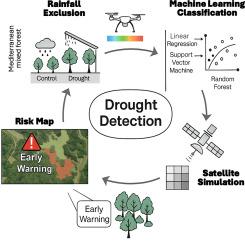Early detection of drought-stressed stands in Mediterranean forests using remote sensing and machine learning classification models in a rainfall exclusion experiment
IF 5.7
1区 农林科学
Q1 AGRONOMY
引用次数: 0
Abstract
Climate change-driven droughts increasingly threaten Mediterranean forests. Early detection is crucial for mitigating long-term impacts; yet, conventional methods are limited in spatial and temporal coverage. Remote sensing offers a large-scale solution, but its application at the individual-tree level remains limited, particularly in mixed-species forests.
We combined a controlled rainfall exclusion experiment with drone-based hyperspectral imaging and machine learning to classify drought stress at the individual-tree level in a semi-arid Mediterranean forest (Yishi Forest, Israel). Six 0.05-ha plots with five co-occurring tree species were monitored over two hydrological years. Hyperspectral data (274 bands, 400–1000 nm) were used as is and after synthetically simulating Planet, VENµS, and Sentinel-2 bands in three machine learning classification models.
Results show that rainfall was reduced by nearly half in treated plots. Standard physiological metrics—leaf water potential, carbon assimilation, and transpiration—showed limited treatment sensitivity across most species and seasons, whereas hyperspectral-driven machine learning classification models accurately distinguished between drought-treated and control stands. Logistic Regression (LR) outperformed Support Vector Machines (SVM) and Random Forest (RF), reaching an accuracy of 0.85, a recall of 0.94, and an F1 score of 0.83 in classifying treated stands on a held-out test set. High performance persisted after reducing input to 21 bands. Simulated satellite spectral data showed that SVM performed best using VENµS bands (accuracy = 0.74, F1 = 0.73). When applied to real VENµS imagery from three independent forest sites, the model identified areas of high drought risk one to two years before visible canopy decline.
The presented approach offers a scalable and transferable tool for real-time forest drought monitoring, supporting early warning systems amid growing climate pressures.

降雨排除试验中基于遥感和机器学习分类模型的地中海森林干旱胁迫林分早期检测
气候变化导致的干旱日益威胁地中海森林。早期发现对于减轻长期影响至关重要;然而,传统方法在空间和时间覆盖方面是有限的。遥感提供了一种大规模的解决办法,但其在单树水平上的应用仍然有限,特别是在混合树种森林中。我们将控制降雨排除实验与基于无人机的高光谱成像和机器学习相结合,在半干旱的地中海森林(以色列Yishi森林)的个体-树水平上对干旱胁迫进行分类。在2个水文年的时间里,对6块面积为0.05公顷的地块进行了5种共生树种的监测。高光谱数据(274个波段,400-1000 nm)在三种机器学习分类模型中综合模拟Planet、VENµS和Sentinel-2波段后,按原样使用。结果表明,在处理过的地块上,降雨量减少了近一半。标准生理指标——叶片水势、碳同化和蒸腾——在大多数物种和季节表现出有限的处理敏感性,而高光谱驱动的机器学习分类模型能够准确区分干旱处理和对照林分。逻辑回归(LR)优于支持向量机(SVM)和随机森林(RF),在hold out测试集上对处理过的林分进行分类的准确率为0.85,召回率为0.94,F1得分为0.83。将输入减少到21个波段后,仍然保持高性能。模拟卫星光谱数据表明,SVM在VENµS波段表现最佳(精度= 0.74,F1 = 0.73)。当应用于三个独立森林点的真实VENµS图像时,该模型在可见的冠层下降前一到两年确定了高干旱风险地区。所提出的方法为实时森林干旱监测提供了一种可扩展和可转移的工具,支持日益增长的气候压力下的早期预警系统。
本文章由计算机程序翻译,如有差异,请以英文原文为准。
求助全文
约1分钟内获得全文
求助全文
来源期刊
CiteScore
10.30
自引率
9.70%
发文量
415
审稿时长
69 days
期刊介绍:
Agricultural and Forest Meteorology is an international journal for the publication of original articles and reviews on the inter-relationship between meteorology, agriculture, forestry, and natural ecosystems. Emphasis is on basic and applied scientific research relevant to practical problems in the field of plant and soil sciences, ecology and biogeochemistry as affected by weather as well as climate variability and change. Theoretical models should be tested against experimental data. Articles must appeal to an international audience. Special issues devoted to single topics are also published.
Typical topics include canopy micrometeorology (e.g. canopy radiation transfer, turbulence near the ground, evapotranspiration, energy balance, fluxes of trace gases), micrometeorological instrumentation (e.g., sensors for trace gases, flux measurement instruments, radiation measurement techniques), aerobiology (e.g. the dispersion of pollen, spores, insects and pesticides), biometeorology (e.g. the effect of weather and climate on plant distribution, crop yield, water-use efficiency, and plant phenology), forest-fire/weather interactions, and feedbacks from vegetation to weather and the climate system.

 求助内容:
求助内容: 应助结果提醒方式:
应助结果提醒方式:


